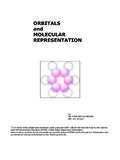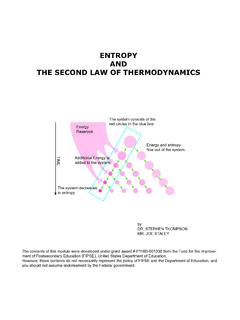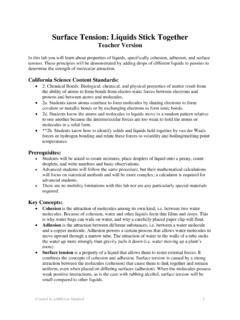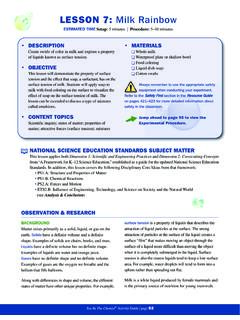Transcription of Chemical Bonding - Colorado State University
1 The contents of this module were developed under grant award # P116B-001338 from the Fund for the Improve-ment of Postsecondary Education (FIPSE), United States Department of , those contents do not necessarily represent the policy of FIPSE and the Department of Education, and you should not assume endorsement by the Federal STEPHEN THOMPSONMR. JOE STALEYN eutral AtomNeutral AtomPositive IonPositive IonPositive IonNegative IonNegative IonNegative IonCHEMICAL BONDING5+5+5+4+4+4+5+5+5+3-2-2-2-2-1-1-1 -1-1+1+1+1+1+1+1+2+2+2+2+2+2+2+2+2+3+3+3 +3+3+3+3+3+3+3+3+3+3+3+3+3+3+3+3+3+3+3+3 +3+3+3+3+3+3+3+3+3+3+3+3+3+3+3+3+3+4+4+2 +2+2+2+2+2+12345678910111213141516171812 345671A2A3A4A5A6A7A8 ACHEMICAL BONDINGCONTENTS2 Electronegativity3 Road Map4 Types Of Bonding5 Properties Controlled By Chemical Bond6 Polar Bonds7 Metallic Bonding8 Intermolecular Forces9 Ions: Counting Electrons And Protons10 Ionic And Atomic Radii11 Ions And Energy12 Lithium Fluoride13 Crystal Packing14 Crystal Packing15 Crystal Packing16 Covalent H217 Quantization18 Bond Length And Strength19 Strong And Weak Bonds20 Strong And Weak Bonds21 Covalent To Metallic22 Electron DelocalizationCHEMICAL BONDINGELECTRONEGATIVITYWhat is the most electronegative element?
2 What is the least electronegative element (aside from the noble gases)?What is the range of electronegativity for the metals? Metalloids? Nonmetals?Why is the electronegativity of the noble gases listed as zero?For an electron shared between hydrogen and chlorine,would you expect the electron to be closer to the hydrogen or the chlorine?HydrogenMetalsMetalloidsNonmeta lsGroup is the ability of an atom to attract shared electrons to is largely the difference between the electronegativities of two atoms which determines what kind of bond is formed between BONDINGROAD MAPHHeLiNaKBeMgCaNeArKrXeRnFONCBClBrIAtA lGaPoRbSrScCrMnFeCoNiCuTiVYZrNbMoTcRuRhP dAgZnCdCsBaLaHfTaFrRaAcRfHaSgNsHsMtWReOs IrPtAuHgInTlPbBiCePrNdPmSmEuGdTbDyHoErTm YbLuLrNoMdFmThPaUNpPuAmCmBkCfEsNonMetals and HNonMetals and HCovalentBondingNonMetals and HGroups 1 and 2 MetalsMetalsMetalsHydrogenMetalsMetalloi dsNonmetalsGroup 18 IonicBondingMetallicBondingOther MetalsPolarBondingNonMetals and HElectronegativityNon MetalloidsPolarBondingMetalloids1A2A3A4A 5A6A7A8A3 Chemical BONDINGTYPES OF BONDINGThe different types of Chemical Bonding are determined by how the valence electrons are shared among the bonded Electron CloudIn IONIC Bonding the valence electrons are com-pletely transferred from one atom to the other bonds occur between
3 Metals and nonmetals when there is a large difference in BondingIn COVALENT Bonding the valence electrons are shared as pairs between the bonded atoms. Pure covalent Bonding only occurs when two nonmetal atoms of the same kind bind to each other. When two different nonmetal atoms are bonded or a nonmetal and a metal are bonded, then the bond is a mixture of cova-lent and ionic Bonding called polar covalent BondingIn METALLIC Bonding the valence electrons are shared among all of the atoms of the Bonding occurs when metals bond to either themselves or mixed with other metals in BondingFilled electron shell core4 Polar BondingIn POLAR Bonding the electrons are shared but NOT equally. Many compounds have the characteris-tics of BOTH ionic and covalent Bonding . Electronega-tivity differences determine the balance of the periodic table of electronegativities from the last page, write down examples of atom pairs which you would expect to form covalent bonds, polar covalent bonds and ionic BONDINGM etallicMalleable melting point and boiling in in nonpolar heat and : gold, copperIonicCrystalline high melting in in nonpolar of heat and electricity in aqueous : NaCl, CaCOExamples: NaCl, CaCO33 CovalentGas, liquid, or a soft melting point and low boiling in H2 OSoluble in nonpolar of heat and the list of properties on the left, try to assign as many of the common substances in your environ-ment to one of the types of Bonding determines the physical properties of substances.
4 These properties are listed below for covalent, ionic and metallic and describe some substances which do not seem to fi t into any of the three types of CONTROLLED BY Chemical BOND5 Chemical BONDINGPOLAR BONDSS eparated AtomsIonic BondPolar Covalent BondCovalent BondIn the picture above, the separated atoms look , in fact, they are the same kind of atom, which of the three bonds shown is possible?Why only that one?What other type of Bonding is possible between identical atoms?Filled electron shell coreValence electron(s)Ionic and covalent bonds are two ideal bonds share characteristics of both ionic and covalent Bonding . They are called polar covalent bonds and they tend to occur between atoms of mod-erately different polar covalent bonds the electrons belong predomi-nantly to one type of atom while they are still partially shared by the other type, as illustrated in the following pictures of the valence electron the chart of electronegativities, arrange the following compounds in an order from most ionic to most covalent:Al2O3 , CaCl2 , NaF , O2 , NaCl, 6 METALLIC BONDINGM etals are formed from elements on the left hand side of the periodic table.
5 Having generally low electroneg-ativity they tend to lose their valence electrons easily. When we have a macroscopic collection of the same or similar type of metallic atoms, the valence electrons are detached from the atoms but not held by any of the other atoms. In other words, these valence elec-trons are free from any particular atom and are only held collectively by the entire assemblage of a metal the ion cores are held more or less at fixed places in an ordered, or crystal, lattice. The valence electrons are free to move about under applied stimu-lation, such as electric fields or , such as electric fields or is the origin of electrical and thermal conductivity in sodium metal?Why do metals exhibit a wide range of melt-ing points and hardness? Chemical BONDING2+2+2+2+2+2+2+2+2+2+2+Picture 1 presents a regular arrangement of the ion cores for a metal with a single valence electron per atom as well as a snapshot of the location of the freely moving valence 2 shows a collection of ion cores for a metal with two valence electrons.
6 Draw in the valence electrons. (Little circles are good enough.) HINT: Metals are neutral in ELECTRON SEA MODEL FOR METALS7+++++++++ee-ee-ee-ee-ee-ee-ee-ee- e-In addition to covalent, polar, ionic and metallic bond-ing there are intermolecular forces which contribute to the stability of things. These include dipole-dipole forces, hydrogen Bonding and London dispersion FORCESLONDON DISPERSION FORCES quantum effectquantum effectquantum effectquantum effectorinducedinducedF-FF-FCHEMICAL BONDINGINTERMOLECULAR FORCESHYDROGEN BONDINGMany molecules are electric dipoles, that is, they have net positive charge on one part of the molecule and net negative charge on another part. Since opposite charges attract and like charges repel, these molecules will tend to orient themselves so that there is the most attraction and the least is dipole-dipole interaction more important in liquids than in solids?Why is it more important in liquids than in gases?Can homonuclear diatomic molecules such as H2, O2and N2 have dipole-dipole forces?
7 A particularly strong and important variety of dipole-dipole interaction is called hydrogen Bonding . A hydrogen atom on one molecule is attracted to a highly electronegative atom in another molecule. Hydrogen Bonding is strong both because of the high polarity involved and because the small size of the hydrogen atom permits a close approach between it and the electronegative atomHydrogen Bonding is particularly noted between wa-ter molecules, but from the description given above you should be able to deduce other substances in which hydrogen Bonding nonpolar molecules have a random fl uctuation of charge making the molecule temporarily polar. This then induces an opposite fl uctuation in a neighboring molecules so that the two molecules have opposite charges on their near sides and attract each INTERACTIONHYDROGEN BONDINGWATERMOLECULEHYDROGENOXYGEN8 Chemical BONDINGIONS: COUNTING ELECTRONS AND PROTONS3+LiIn the pictures below, draw in the number of elec-trons required to make the atom neutral and write the element symbol in the box to the left of the +17+17+8+9+NEUTRAL ATOMSPOSITIVE IONSP ositive ions have more protons than the number of protons an atom has is fi xed in ordinary Chemical reactions, positive ions are produced by removing electrons from the +Li+In the pictures below draw in the number of electrons needed to make the ion named in the +O2-9+F-NEGATIVE IONSN egative ions have more electrons than the number of protons is unchanged from the neutral atom, negative ions are formed by the addition of the pictures below draw in the number of electrons needed to make the ion named in the +11+11+Na+12+12+12+Mg2+Neutral atoms have the same number of electrons as protons.
8 In the picture below, the nuclear charge is represented by the gray circle marked 3+, for the 3 protons in the nucleus of lithium. Electrons are marked as horizontal dashes, one for each BONDINGATOMIC AND IONIC RADII5+5+5+4+4+4+5+5+5+3-2-2-2-2-1-1-1-1 -1+1+1+1+1+1+1+2+2+2+2+2+2+2+2+2+3+3+3+3 +3+3+3+3+3+3+3+3+3+3+3+3+3+3+3+3+3+3+3+3 +3+3+3+3+3+3+3+3+3+3+3+3+3+3+3+4+4+2+2+2 +2+2+2+123456789101112131415161718123456 7In this version of the periodic table the relative sizes of both neutral atoms and of their most common ions are shown, as well as the charges on their ions. The atoms are shown as black outline circles and the ionic diameters are colored blue for positive ions and red for negative are the positive ions smaller than their neutral atoms while the negative ions are larger than the neutral atoms?Why do both ions and atoms tend to grow larger as we go down the periodic table?What is the smallest atom? What atom has the smallest ion (too small to show on the table)?
9 Find the largest atom and identify it on a standard periodic kind of ions do atoms with large electronegativi-ties tend to form?What makes the atoms and ions in the middle of peri-ods 4, 5 and 6 so small? What makes the samarium atom so large?Identify the two kinds of atom which appear about the same size as their ion and explain why this is are the antimony and beryllium ions so small? Differentiate between the are the Lanthanide ions of such similar size?How might you use the chart of atomic and ionic radii to explain the strengths of ionic Bonding between various ions?Compare the ionic and atomic radii table above with the chart of electronegativities and attempt to explain as many aspects of the sizes of atoms and ions in terms of electronegativity as AtomPositive IonNegative Ion1A2A3A4A5A6A7A8A10 Chemical BONDINGIONS AND ENERGY ENERGY0 0 Add Energy e-0 Add More EnAdd More Energy ENERGY0e-The diagrams above show the ground State of the lithium atom, followed by an excited State , followed by the lithium ion with the free electron.
10 What is the charge of the lithium ion in the right hand drawing?In the diagrams above, draw in the electrons as ar-rows which occupy the ground State orbitals of the sodium atom in the left hand picture. In the right hand picture draw in the orbitals and electrons of the sodium e-0 + EnergyThe diagrams above show the ionization of fl is the charge of the fl uoride ion?ENERGY0e-0In the diagrams above, draw in the electrons (arrows) for the chlorine atom on the left and for the chloride ion on the right. What is the charge of the chloride ion?11 ENERGY0 Chemical BONDINGLITHIUM FLUORIDE2Li(s) 2Li(g)2Li(g) 2Li+(g) + 2e-(g)F2(g) 2F(g)2F(g) + 2e-(g) 2F-(g)2Li+(g) + 2F-(g) 2Li+F-(s)It requires 155 kJ/molto separate lithium atomsfrom their body centered cubic requires 520 kJ/molto ionize lithium atoms. LiLi+e-+It requires 80 kJ/molto dissociate the difl uoride molecule. e- Ionization of the fl uorine atom gives off 328 kJ/molof the lithium and fl uoride ions into their crystal gives off 1030 kJ/mol of the energies which are associated with the process a making lithium fl uoride crystal lithium crystal and difl uoride molecules.










